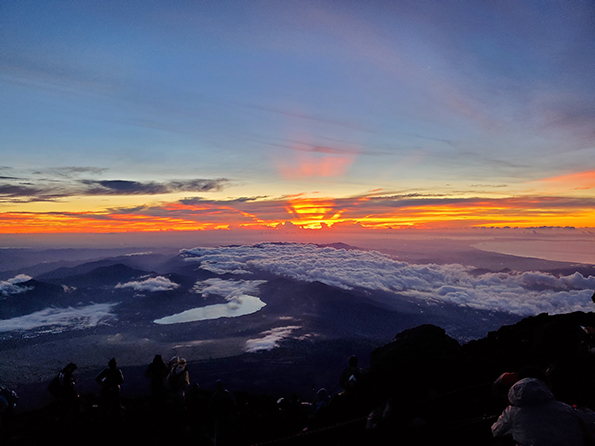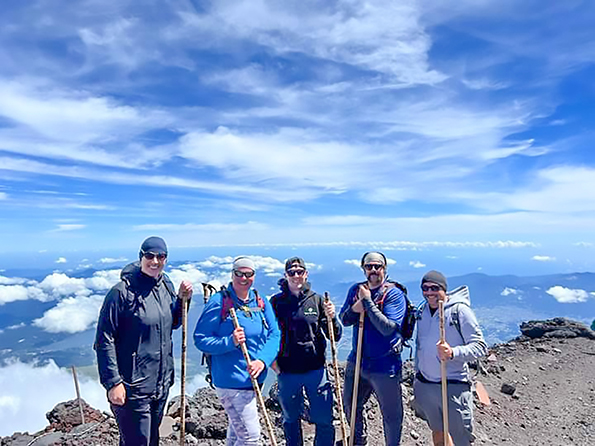Once in a blue moon: Climbing Mount Fuji in Japan overnight
By Lookout Production on Sep 23, 2023 with Comments 0

Lieutenant (Navy) Rhys Davies
HMCS Vancouver Operations Officer
—
‘Once in a blue moon’ is an expression that rarely coincides with a once-in-a-lifetime opportunity and an actual blue moon. In this case, a lucky few of His Majesty’s Canadian Ships (HMCS) Ottawa and Vancouver’s crew climbed Mount Fuji’s summit during August’s second full moon: coincidentally, a ‘super blue moon’.
After determining that climbing overnight was feasible, planning started earnestly to climb Japan’s tallest peak. The full moon rose just before eight o’clock in the evening, and we set off by its light from the Subaru 5th station at 2,300 meters. After a seemingly short hike, still excited and buzzing with the energy of the adventure, we reached the 6th station. The ranger reported 3 degrees Celsius and 45 kilometres per hour winds at station 9. We were warm and had just stripped off our light sweaters as the exertion built and we continued on the remarkably vacant paths. As we climbed the switchbacks of volcanic sand and gravel, the vista East towards Tokyo emerged from behind the clouds, and a gentle breeze cooled the sweat on our brows.
We had our Fuji walking sticks stamped at Station 7 with a hot iron that branded the station’s badge into the wood. Each station has a distinct brand; the stamps are collected as you climb and indicate the height attained. By Station 8, we realized it was getting windy and cold. It was just past midnight, and we decided to slow down. It was now about 8 degrees Celsius and quite breezy, so we decided to have a snack and find shelter under an overhang by making an improvised bivouac (a temporary camp without tents or cover). As none of us had camping gear, shelter was accomplished by repurposing heavy-duty Mylar bags. Some climbers from our team fell asleep, while the others watched as the uphill traffic increased.
Eventually, the first tour group passed us, and, wanting to stay caught up, we roused ourselves and raced to Station 8.5. We surmised this tour group had climbed to a lower station the previous day and had rested, eaten, and set off leisurely to arrive at the summit in time for the sunrise. The wind had built considerably by this stage, and we had been exposed to the wind and cold for five consecutive hours. With each successive station disgorging its freshly awakened inhabitants into the chilly early morning air, traffic on the single-track path felt like the Fuji equivalent of the morning ‘Colwood Crawl’ on the way into CFB Esquimalt. The wind increased, lashing the huddled procession with fine grit and sand. Rangers along the route chivvied the harried climbers to keep moving, and several of the climbers pulled out onto the slope side to rest while the river of humanity flowed past, ever upward.
At Station 9, we donned our last warm layer and readied ourselves for the push to the top. The masses were paused at this station, with many huddled in the station’s lee and the bathrooms. Having paid the entry fee of 200 yen and enjoyed the surprise of a heated seat, I must admit we were tempted to stay with them. Instead, we decided to push from this last station to the caldera’s rim. We pushed through the final 400 meters of elevation gain and were nearly blown off our feet by the strength of the wind at the top. We made our way gingerly to the edge of the eastern slope and hunkered down behind some rocks where we could see the eastern skyline. We covered up with our makeshift bags as we wished for a hot cup of tea and a break from the wind, and we waited and watched as the land of the rising sun earned its name.
The sunrise that followed set the underbellies of the low-horizon clouds aflame. Great fingers of light arched across the sky and spread from the blood-orange glow of the sun. As the sight and warmth of the day’s first rays warmed us, we began to stir from our Mylar cocoons. The sun broke from cover, and we rose to explore the edge of the enormous cone we had climbed. The crowds packed the eastern rim, and the wind continued to howl, so after some exploring and gratuitous photoshoots, we decided to get ahead of the traffic and make our way to the bottom.
The track down was less eventful, but the dusty ash-covered trail was treacherous and needed more access to the plentiful huts we had just climbed past. For those familiar with ski hills, it was like a cat-track through which the huts were resupplied. The air temperature warmed as we descended, and our concerns turned from windburn to sunburn. We were out of the water and realized how high we had trudged the night before as the interminable switchbacks carried on for the 1,600 meters we had climbed.
We returned to the 5th station and headed straight for ice cream. The temperature and humidity were again over 25 degrees Celsius, and we had subsisted on dried fruit and climbing bars overnight. The station, which had been closing as we arrived the day before, was a bustling tourist village with a post office. As we wrote our postcards in the shadow of the iconic mountain, we reflected on the once-in-a-blue-moon adventure we had shared before starting the three-hour journey back to the ship.

Filed Under: Top Stories
About the Author:





